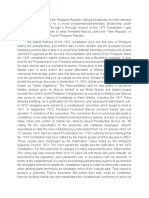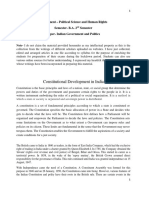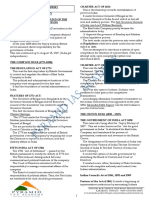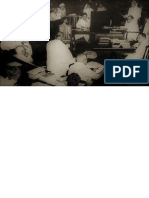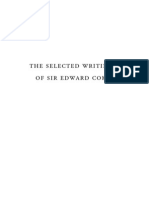Historical Backgrounds (Important Acts)
Historical Backgrounds (Important Acts)
Uploaded by
AMAL BABUCopyright:
Available Formats
Historical Backgrounds (Important Acts)
Historical Backgrounds (Important Acts)
Uploaded by
AMAL BABUOriginal Description:
Original Title
Copyright
Available Formats
Share this document
Did you find this document useful?
Is this content inappropriate?
Copyright:
Available Formats
Historical Backgrounds (Important Acts)
Historical Backgrounds (Important Acts)
Uploaded by
AMAL BABUCopyright:
Available Formats
Historical Backgrounds
British came to India in 1600 as traders, in the form of the East India Company,
which had the exclusive right of trading in India under a charter granted by Queen
Elizabeth-I.
In 1765, the Company, which till now had purely trading functions obtained the
‘Diwani’ (i.e., rights over revenue and civil justice) of Bengal, Bihar, and Orissa.
This started its career as a territorial power.
In 1858, in the wake of the ‘Sepoy mutiny, the British Crown assumed direct
responsibility for the governance of India. This rule continued until India was granted
independence.
In 1946 Constituent Assembly was formed for making a constitution & finally on
January 26, 1950, the Constitution came into being.
Various features of the Indian Constitution and polity have their roots in the British
rules.
We are going to discuss this background history in two phases, The Company Rule &
The Crown Rule.
The Company Rule (1773 – 1858)
1. Regulating Act – 1773
The first step was taken by the British govt to establish British rule in INDIA
(a) it was the first step taken by the British Government to control and regulate the
affairs of the East India Company in India.
(b) it recognized, for the first time, the political and administrative functions of the
Company.
(c) it laid the foundations of central administration in India.
Governor Bengal become Governor-General of Bengal
2024 Presented by Situ Sir # 1
Supreme Court was established 1774 Calcutta (1 + 3 = 4 judges)
This Court was independent of Governor-General and Council.
It prohibited the servants of the Company from engaging in any private trade or
accepting presents or bribes from the natives.
It strengthened the control of the British Government over the Company by requiring
the Court of Directors (the governing body of the Company) to report on its revenue,
civil, and military affairs in India.
In a bid to rectify the defects of the Regulating Act of 1773, the British Parliament
passed the Amending Act of 1781 also known as the Act of Settlement.
2. Pitts Act of India - 1784
The Dual Government System was established
Company territory called British province
It allowed the Court of Directors to manage the commercial affairs.
A new body called the Board of Control managed the political affairs. Thus, it
established a system of double government.
Members of the Governor-General Council were reduced to 3
Non - intervention policy
The Company’s territories in India were for the first time called the ‘British possessions
in India’
Act of 1786
- In 1786, Lord Cornwallis was appointed as the Governor-General of Bengal.
- He placed two demands to accept that post, viz.,
1. He should be given the power to override the decision of his council in special
cases.
2. He would also be the Commander-in-Chief.
2024 Presented by Situ Sir # 2
3. Charter Act – 1793
Empowered Governor to act as an Agent of the council in special condition
Given another 20 years of company Monopoly trade
It extended the overriding power given to Lord Cornwallis over his council, to all future
Governor Generals and Governors of Presidencies.
It gave the Governor-General more powers and control over the governments of the
subordinate Presidencies of Bombay and Madras.
4. Charter Act – 1813
Deprived/End the Company Monopoly trade. Indian trade was thrown open to all
British merchants.
However, it continued the monopoly of the company over trade in tea and trade with
China.
Madras, Bombay, and Calcutta Council was empowered but subject to Greater control
under the British Parliament, Before making the final decision, British Parliament will
look after the matter.
Asserted the sovereignty of the British Crown over the Company’s territories in India.
It allowed the Christian missionaries to come to India to enlighten the people.
It provided for the spread of western education among the inhabitants of the British
territories in India.
It authorized the Local Governments in India to impose taxes on persons. They could
also punish the persons for not paying taxes.
5. Charter Act -1833
The Governor-General of Bengal became Governor-General of India
William Bentinck, first Governor-General of India
East India Company transferred from a Council body to an administrative body
This act was called ‘Acts’ (Before it was Regulation) The Governor-General of India
was given exclusive legislative powers for the entire British India. The laws made under
2024 Presented by Situ Sir # 3
the previous acts were called Regulations, while laws made under this act were called
Acts.
From this time Governor-General Council knew by Govt. of India and this Council
become the ‘Indian Council’
The Charter Act of 1833 attempted to introduce a system of open competition for the
selection of civil servants and stated that the Indians should not be debarred from
holding any place, office, or employment under the Company.
6. Charter Act – 1853
For the first time, the Legislative and Executive were separated from the Governor-
general Council.
Civil service was introduced, and it was thrown open for Indians
1854 -Macaulay Committee was appointed. (Committee on the Indian Civil Service)(
Lord Cornwallis -father of civil service)
6 members were added to the executive Council which belongs to the governor-general
from four members were appointed by the local (provincial) governments of Madras,
Bombay, Bengal, and Agra.
It extended the Company’s rule and allowed it to retain the possession of Indian
territories on trust for the British Crown.
But, it did not specify any particular period, unlike the previous Charters. This was a
clear indication that the Company’s rule could be terminated at any time the Parliament
liked.
The Crown Rule (1858 – 1947)
1. Govt of India Act – 1858
This significant Act was enacted in the wake of the Revolt of 1857–also known as the
First War of Independence or the ‘sepoy mutiny.
Known as the Good Governance Act.
2024 Presented by Situ Sir # 4
East India company was Abolished.
All power was transferred to the British crown
It ended the system of double Government by abolishing the Board of Control and
Court of Directors
All rights transferred to the ‘Secretary of state for India’ (It created a new office,
vested with complete authority and control over Indian administration.)
Secretary of India assisted by Indian Council (15 members)
2. Indian Council Act – 1861
After the great revolt of 1857, the British Government felt the necessity of seeking the
cooperation of the Indians in the administration of their country.
In pursuance of this policy of association, three acts were enacted by the British
Parliament in 1861, 1892, and 1909.
The Indian Councils Act of 1861 is an important landmark in the constitutional and
political history of India.
Introduced Representative Institution of India (associating Indians with the law-
making process)
For the first time, Indians were called to help administrative process
Decentralization - Bombay and Madras governments played an active role from this
time.
Portfolio System was introduced by Lord Canning in 1859 through this act.
It empowered the Viceroy to issue ordinances, without the concurrence of the legislative
council, during an emergency. The life of such an ordinance was six months.
As a result of this Act in 1937 Internal Autonomy of Province was established
2024 Presented by Situ Sir # 5
3. Indian Council Act – 1892
Provincial legislative autonomy. (Increased the number of additional (non-official)
members)
Council allowed to discuss ‘Annual Finance Report’
The member of the legislative council was nominated by Governor-General, Chamber of
Commerce & Zamindar Sabha worked as an advisory body.
4. Indian Council Act – 1909
First time ‘Separated representation’ for the Muslim community,
Known as Morley -Minto reforms (Morley= Secretary, Minto= Viceroy)
This act Legalised Communalism.
Lord Minto was known as Father of Communal Electorate
Members of the Legislative Council get the right to put vote except in non-voteable area
The number of members in the Central legislative council was raised from 16 to 60.
Central > Official member majority
Province > non-official member along with Nominated members
Satyendra Prasad Sinha -First Indian to join the ‘executive Council of Viceroy’
It also provided for the separate representation of presidency corporations, chambers of
commerce, universities, and zamindars.
(Extra). 1932 - Communal Award- British PM- Ramsay MacDonald
5. Govt of India Act – 1919
2024 Presented by Situ Sir # 6
On August 20, 1917, the British Government declared, for the first time, that its
objective was the gradual introduction of a responsible Government in India.
The Government of India Act of 1919 was thus enacted, which came into force in 1921.
Known as Montague -Chelmsford reform. (Montague= Secretary, Chelmsford=
Viceroy)
Dyarchy System of province were established (Derived Greek word ‘de arche’)
Central
Province…… > Subdivided other
> Reserved subject
Central Relaxed the rule in the field of –
>Administrative
>Legislative
> Financial
Governor General was free to nominate as many members as he wants to the Executive
Council
Central Legislative consists of two houses
-Council of state (60 members) 34 were elected
-Legislative Assembly (144 members) 104 were elected
Power of both houses kept equal, except voting power which is exclusively given to the
‘Legislative Assembly’
It introduced, for the first time, bicameralism and direct elections in the country.
It provided for the establishment of Public Service Commission
6. Govt of India Act – 1935
Dyarchy in Provinces ware abolished & Provincial Autonomy was introduced in that
place.
Dyarchy’ was adopted at the ‘Centre’
2024 Presented by Situ Sir # 7
Federal Govt Started –
>Province
>Princely state
Administrations were divided into 3 categories –
>Federal list (for Centre, with 59 items)
>Provincial list (for provinces, with 54 items)
>Concurrent list (for both, with 36 items)
Federal subject divided
>Reserved subject
> Transferable subject
Out of 11 provinces 6 provinces Adopted Bi-cameralism
Legislative Council (Upper House)
Legislative Assembly (Lower House)
6 Bicameralism Provinces are,
Bihar, Bengal, Assam, Bombay, Madras and United province
It further extended the principle of communal representation by providing separate
electorates for depressed classes (Scheduled Castes), women and labour (workers).
It abolished the Council of India, established by the Government of India Act of 1858.
It provided for the establishment of a Reserve Bank of India to control the currency and
credit of the country.
It provided for the establishment of Federal Court, which was set up in 1937.
Local self Govt is a Provincial subject
2024 Presented by Situ Sir # 8
7. Indian Independence Act – 1947
On February 20, 1947, British Prime Minister Clement Atlee declared that the British
rule in India would end by June 30, 1948.
On June 3, 1947, the British Government made it clear that any Constitution framed by
the Constituent Assembly of India (formed in 1946) cannot apply to those parts of the
country which were unwilling to accept it.
On the same day (June 3, 1947), Lord Mountbatten, the Viceroy of India, put forth the
partition plan, known as the Mountbatten Plan.
The plan was accepted by Congress and the Muslim League. The immediate effect was
given to the plan by enacting the Indian Independence Act (1947).
Ending the British rule and India declared as an independent Sovereign state
Created two independent domains India & Pakistan
Post of Viceroy was Abolished
It granted freedom to the Indian princely states either to join the Dominion of India or
Dominion of Pakistan or to remain independent.
It designated the Governor-General of India and the provincial governors as
constitutional (nominal) heads of the states. They were made to act on the advice of the
respective council of ministers in all matters.
‘Secretary state of India’ abolished and power transfer to ‘Secretary state for
Commonwealth affairs’
Lord Mountbatten became the first Governor General of new Dominion of India
Interim Govt was established in 1946
Indian Independence Bill was introduced in 4th July 1947 (The Indian independence
Bill received the Royal Assent on the date of 18th July.
The Indian Constitution Cornerstone of Nation - Granville Austin
2024 Presented by Situ Sir # 9
You might also like
- Ghatnachakra PolityDocument420 pagesGhatnachakra PolityAnand Kumar67% (3)
- HousedirectoryDocument205 pagesHousedirectoryapi-253001904No ratings yet
- RPH 2Document2 pagesRPH 2Daniela Pearl JumuadNo ratings yet
- Cardioversor D10 - TEBDocument39 pagesCardioversor D10 - TEBBrunoNo ratings yet
- Government HaryanaDocument167 pagesGovernment HaryanaRishabNo ratings yet
- Historical Background WatermarkDocument12 pagesHistorical Background Watermarkami782440No ratings yet
- Various Topics Under Part-1: Historical BackgroundDocument8 pagesVarious Topics Under Part-1: Historical Backgroundkush_112No ratings yet
- Unit 4 HistoryDocument9 pagesUnit 4 Historyjyuvi360No ratings yet
- Historical Background of Indian Constitution NotesDocument9 pagesHistorical Background of Indian Constitution NotesSri Krishna Bharadwaj Godavari100% (1)
- M.lakshmikant Chapter 1Document17 pagesM.lakshmikant Chapter 1Shivankar sukulNo ratings yet
- Indian PolityDocument4 pagesIndian Polityfandufacts4No ratings yet
- Historical Background of The Constitution of IndiaDocument7 pagesHistorical Background of The Constitution of IndiaStaffy KaurNo ratings yet
- Consti NotesDocument10 pagesConsti NotesPratiksha PraveenNo ratings yet
- PolityDocument62 pagesPolitySubhangi PodderNo ratings yet
- By Ankit Bajad SirDocument49 pagesBy Ankit Bajad SirMonalisha PattraNo ratings yet
- Political ScienceDocument15 pagesPolitical ScienceVanshika MeenaNo ratings yet
- History Units 1 5 Pages 1 15,22 58Document52 pagesHistory Units 1 5 Pages 1 15,22 58Aahana AcharyaNo ratings yet
- Framing of The Indian ConstitutionDocument7 pagesFraming of The Indian Constitutionprashant panwarNo ratings yet
- Making of Indian ConstitutionDocument35 pagesMaking of Indian ConstitutionKanchan Meena100% (1)
- 1.indian Polity - OnlineIASDocument103 pages1.indian Polity - OnlineIASsureshNo ratings yet
- 2880018indian PolityDocument403 pages2880018indian PolityLokesh kumar palNo ratings yet
- Constitutional Development Regulating Act 1773 To Charter Act 1853 56Document4 pagesConstitutional Development Regulating Act 1773 To Charter Act 1853 56Rajesh KumarNo ratings yet
- 1.historical Development of The Constitution of IndiaDocument14 pages1.historical Development of The Constitution of IndiasanthoshmanikanthaNo ratings yet
- Attachment Historical Background Lyst1937Document53 pagesAttachment Historical Background Lyst1937sachin saurabhNo ratings yet
- Pre Constitutional ActsDocument10 pagesPre Constitutional ActsFredrick Russel LionelNo ratings yet
- Charters and ActsDocument107 pagesCharters and Actsradhaupadhyay150No ratings yet
- Value Addition Notes (History of Constitution Making) - PDF OnlyDocument8 pagesValue Addition Notes (History of Constitution Making) - PDF Onlymratyunjay baghelNo ratings yet
- ConstitutionDocument10 pagesConstitutionNikhil ThakurNo ratings yet
- Indian PolityDocument102 pagesIndian PolityPriyanka Ravath100% (1)
- Brief Constitutional History of India: SynopsisDocument7 pagesBrief Constitutional History of India: SynopsisAditya GoyatNo ratings yet
- CH 2 Historical UnderpinningsDocument35 pagesCH 2 Historical UnderpinningsMonikaNo ratings yet
- BA-PoliticalScience-02Sem-DrudaySingh-Indian Government and PoliticsDocument94 pagesBA-PoliticalScience-02Sem-DrudaySingh-Indian Government and PoliticsRISHINo ratings yet
- UntitledDocument183 pagesUntitledPunit TiwariNo ratings yet
- Part-1 Constitutional FrameworkDocument8 pagesPart-1 Constitutional Frameworkkush_112No ratings yet
- Full PolityDocument44 pagesFull PolityBalaji vNo ratings yet
- 2.historical Perspective of Constitution of IndiaDocument14 pages2.historical Perspective of Constitution of IndiaziddumurthyNo ratings yet
- HISTORY AND EVOLUTION OF INDIAN CONSTITUTION NOTES 2 UNIT 2.Document19 pagesHISTORY AND EVOLUTION OF INDIAN CONSTITUTION NOTES 2 UNIT 2.mukeshbhatnagarbhatnagar1No ratings yet
- Laxmikant SampleDocument3 pagesLaxmikant Sampleroshan.cnb27No ratings yet
- Laxmikanth Summary - Constitution of India - Famous Books For UPSC Exam (Summary and Tests) PDF DownloadDocument16 pagesLaxmikanth Summary - Constitution of India - Famous Books For UPSC Exam (Summary and Tests) PDF Downloaddarshannn6429No ratings yet
- Political Science Sem 2Document13 pagesPolitical Science Sem 2Akshat AnandNo ratings yet
- VLKC NotesDocument17 pagesVLKC Notesarun_s_7rNo ratings yet
- New Indian Polity BookDocument64 pagesNew Indian Polity BookvasanthNo ratings yet
- Day 1 Quick Revision Polity 120 Days Upsc Perlims 2021 10pointerDocument8 pagesDay 1 Quick Revision Polity 120 Days Upsc Perlims 2021 10pointerAllindiatestNo ratings yet
- Constitutional Development of India Upsc Notes 23Document6 pagesConstitutional Development of India Upsc Notes 23Deshiha SNo ratings yet
- Indian Polity Full PDF EM PDFDocument127 pagesIndian Polity Full PDF EM PDFnitshya samNo ratings yet
- Polity Class 1Document78 pagesPolity Class 1baishyaarnab27No ratings yet
- Modern HistoryDocument13 pagesModern Historynitindefence222No ratings yet
- Constitutional Development of India 1773-1950Document6 pagesConstitutional Development of India 1773-1950SANTOSH CHAUHANNo ratings yet
- UntitledDocument78 pagesUntitledBAJLUL RAHAMANNo ratings yet
- Making of Constitution Important Acts Constitutional Land Mark Important ProvisionsDocument5 pagesMaking of Constitution Important Acts Constitutional Land Mark Important ProvisionsMushini NagabhushanNo ratings yet
- Medieval HistoryDocument92 pagesMedieval HistoryAmbarish ShankarNo ratings yet
- History and Development of The Constitution of IndiaDocument9 pagesHistory and Development of The Constitution of IndiaAnonymous uxd1ydNo ratings yet
- Constitutional Development Through Reasonable ReformsDocument12 pagesConstitutional Development Through Reasonable Reforms125087049No ratings yet
- Historical Background I-MinDocument14 pagesHistorical Background I-MinchandaniifmNo ratings yet
- History of Indian ConstitutionDocument8 pagesHistory of Indian ConstitutionsrivenramanNo ratings yet
- Constitutional Development in IndiaDocument22 pagesConstitutional Development in IndiaPratibha VermaNo ratings yet
- Constitution NotesDocument87 pagesConstitution NotesDeepika SNo ratings yet
- Constitution of India: A Historical CreationDocument9 pagesConstitution of India: A Historical CreationRajivShahNo ratings yet
- Indian Polity and Constitution Topicwise Mcqs ExplanationDocument187 pagesIndian Polity and Constitution Topicwise Mcqs Explanationharika1294No ratings yet
- Contitutional Development 1773 1947Document16 pagesContitutional Development 1773 1947Deshiha SNo ratings yet
- Indian PolityDocument45 pagesIndian PolityRajni DubeyNo ratings yet
- Life/Death Rhythms of Capitalist Regimes – Debt Before Dishonour: Part Iii Forecast DominanceFrom EverandLife/Death Rhythms of Capitalist Regimes – Debt Before Dishonour: Part Iii Forecast DominanceNo ratings yet
- Law and the Economy in a Young Democracy: India 1947 and BeyondFrom EverandLaw and the Economy in a Young Democracy: India 1947 and BeyondNo ratings yet
- Operation Red Dragon (EN)Document39 pagesOperation Red Dragon (EN)ALDE ADLENo ratings yet
- SEC Assignment: Submitted By: Sonali Thongram B.A. Economics (Honours) Roll No:22/080Document14 pagesSEC Assignment: Submitted By: Sonali Thongram B.A. Economics (Honours) Roll No:22/080hannakhumanNo ratings yet
- Constitutional Law 1Document32 pagesConstitutional Law 1Logan LoganNo ratings yet
- Congressional Letter On TEF To Eric HolderDocument4 pagesCongressional Letter On TEF To Eric HolderhearstaustinNo ratings yet
- BMC Act 1888Document346 pagesBMC Act 1888Akshay Ramade100% (1)
- Article 12 Under The Indian ConstitutionDocument2 pagesArticle 12 Under The Indian ConstitutionRiddhi FuriaNo ratings yet
- Borneo 1 BruneiDocument9 pagesBorneo 1 Bruneihienlt33No ratings yet
- Wyoming Firearms Freedom Act (HB0095)Document9 pagesWyoming Firearms Freedom Act (HB0095)Joseph Ford Jr.No ratings yet
- Women's Land RightsDocument7 pagesWomen's Land RightsPraygod ManaseNo ratings yet
- Constitutional Law ReviewDocument1,594 pagesConstitutional Law ReviewMark Pasco100% (1)
- 2016 Static GK Capsule by AffairsCloud - V1-MinDocument135 pages2016 Static GK Capsule by AffairsCloud - V1-MinantoNo ratings yet
- Law 416 Question 16Document3 pagesLaw 416 Question 16Zikri Afham Borhan100% (1)
- French RevolutionDocument42 pagesFrench RevolutionHurmull ZurmlofNo ratings yet
- Edward Coke Vol IDocument610 pagesEdward Coke Vol IBrian Stinson100% (1)
- Robert Schuman Declaration 9 May 1950Document13 pagesRobert Schuman Declaration 9 May 1950Apostolos M ChristofisNo ratings yet
- E 07-03-2022 Power Interruption Schedule 1Document21 pagesE 07-03-2022 Power Interruption Schedule 1News CutterNo ratings yet
- 30 Supremo Amicus 431Document8 pages30 Supremo Amicus 431Vaibhav SanklechaNo ratings yet
- Global Governance Models in HistoryDocument22 pagesGlobal Governance Models in HistoryThurgkasiny MuthukumarNo ratings yet
- The Choral Music of Irish Composer Michael McGlynnDocument288 pagesThe Choral Music of Irish Composer Michael McGlynnkylenelson22No ratings yet
- Constitution of Zambia (Amendment), 2016-Act No. 2 - 0Document110 pagesConstitution of Zambia (Amendment), 2016-Act No. 2 - 0Fred ChinsingaNo ratings yet
- 11 - Chapter 4 PDFDocument43 pages11 - Chapter 4 PDFSajiDatinaNo ratings yet
- Chief Minister GE Sem IIDocument2 pagesChief Minister GE Sem IIAditya NishadNo ratings yet
- Melting Pot Essay: Madalina Bitca Flex-Moldova Colorado Spring, Colorado 2018-2019Document2 pagesMelting Pot Essay: Madalina Bitca Flex-Moldova Colorado Spring, Colorado 2018-2019Diana BitcaNo ratings yet
- Deliberative Independent Technocracy v. Democratic Politics - WilDocument17 pagesDeliberative Independent Technocracy v. Democratic Politics - WilSorina CarsteaNo ratings yet
- Indian PolityDocument67 pagesIndian PolityAshokkumar GanesanNo ratings yet


